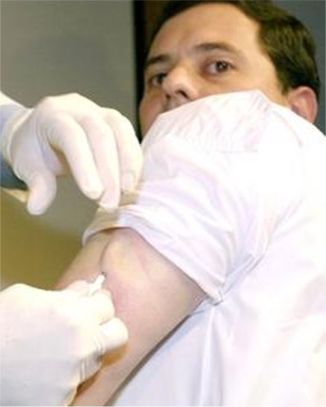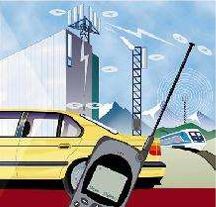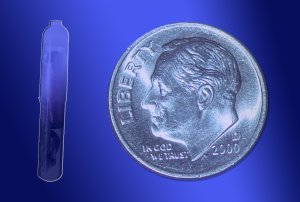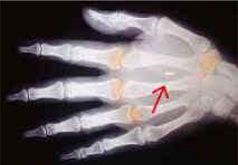So what has been happening so far?
Let's catch up with the recent years! Business Week reported on January 11, 2007:
Business Week reported on January 11, 2007:
Under the federally supported National Animal Identification System (NAIS), digital tags are expected to be affixed to the U.S.'s 40 million farm animals to enable regulators to track and respond quickly to disease, bioterrorism, and other calamities. Opponents have many fears about this plan, among them that it could be the forerunner of a similar system for humans. The theory, circulated in blogs, goes like this: You test it on the animals first, demonstrating the viability of the radio frequency identification devices (RFIDs) to monitor each and every animal's movements and health history from birth to death, and then move on to people.
Well, all you conspiracy buffs, let me introduce you to Kevin McGrath and Scott Silverman. McGrath heads a small, growing company that makes RFID chips for animals…and people.
Silverman heads a second company that sells the rice-size people chips, which are the only ones with Food & Drug Administration (FDA) approval, for implantation in an individual's right biceps. They carry an identity marker that would be linked to medical records. His goal is to create "the first RFID company for people."
***
Larger Farms Join the RFID Program ...
Digital Angel has a big head start in marketing, thanks in part to the Agriculture Dept.-sponsored NAIS program, which, while it is billed as voluntary, is expected by various opponents of NAIS, including Zanoni as well as blogs such as nonais.org, to be imposed on farmers by growing numbers of states. Michigan begins requiring RFID tags for cattle on Mar. 1 in the first such effort (see BusinessWeek.com, 12/19/06, "Farmers Say No to Animal Tags").
Farmers running midsize and large operations are signing up for NAIS in growing numbers. The USDA says 343,186 farms have registered, which translates into millions of animals, driven by what McGrath says are significant economic incentives.
One is inventory control. He points to a pig farm as an example. The farmer can use RFID tags "to monitor the amount fed to the sows, the medications they receive, when they get pregnant, the length of pregnancies, the number born to each sow, and the number of days to weaning."
As another example, he cites a farm with about 5,000 pigs that had an outbreak of disease, where some of the pigs got fever and several died.
By being able to spot health problems earlier via scanning of RFID chips compared to "managing by clipboard," says McGrath, the cost of the disease in lost animals and treatment was about $75,000, vs. an expected $250,000 without chips.
McGrath acknowledges that Digital Angel's chips are more appropriate for factory farms than for smaller farms focused on selling locally. "If you're a farmer who sells to a neighbor, who cares" about RFID chips? "But if you are a farmer who sells to Japan, the Japanese say they want you to categorically state [the animal] is this age and has not had these diseases. If you cannot show this, the Japanese won't buy it." For those farmers who can pass the test, $25-per-head premiums await, he says.
***
People Tags Are More Profitable ...
McGrath, for now, is content to focus Digital Angel on the factory farm market, having seen sales of the animal chip rise from 200,000 in 2003 to about 3 million last year. "We believe we will continue to grow at that rate," he says. In addition, Digital Angel continues selling tags to track lost pets and to monitor fish like salmon for environmental purposes.
Silverman is taking a similar tack with VeriChip by expanding existing markets—the two primary ones are tags for the bracelets and anklets worn by newborn babies and their parents to prevent kidnappings, and those for elderly nursing home patients with Alzheimer's disease to recover "wanderers." Its 2005 revenues were $24 million.
But the big attraction for both companies, and the reason for the upcoming VeriChip public offering, is the lure of implanting the chips into people. McGrath points out that while the RFID chips attached to animals sell for about $1.50 each, and will likely decline to under $1 within a few years because of competitive pressures, the chips for people sell for $25, based on special design to allow implanting. "To the extent they [VeriChip] would need 1 million [chips], it would be huge for us," McGrath says.
For now, VeriChip has only "a couple hundred patients" who have had the RFID chips surgically implanted in their arms. The company is focusing its attention on building databases of patient medical information to attract hospitals to adopt the company's chips. The chips are being targeted at an estimated 45 million "high-risk patients"—diabetics and heart patients, for example, who could be brought into hospitals unconscious or semiconscious and thus not be able to identify themselves.
***
Business May Compel Chip Wearing ...
Of course, no discussion of these cousin companies would be complete without addressing the privacy concerns many people have about being tagged. Both McGrath and Silverman say their companies protect privacy by limiting data stored on the chips for both farm animals and people to identification numbers only, which are extracted via special scanners and then matched to records in databases.
McGrath also says he appreciates the concerns many small farmers have about the potential infringement on their privacy that NAIS represents. "You're dealing with people who are intensely independent," he says. "They don't like people looking over their shoulders."
Silverman says: "We are leaders in the RFID industry in facing privacy issues head on." The chip for people "should always be a voluntary product, with opt-in and opt-out capability."
As comforting as such statements appear, it's important to remember that adoption of the RFID chips doesn't necessarily need to be legislated to become nearly universal. If enough hospitals and insurance companies begin requiring them, or treating patients wearing them more expeditiously than nonusers, or providing discounts for usage of the chips, they well could become the norm. Then, not wearing a chip might be akin to not having a bank ATM card or, increasingly in Eastern states with toll roads and turnpikes, not having a transponder to pay tolls in your car (see BusinessWeek.com, 10/9/06, "Radio-Shipment Tracking: A Revolution Delayed").
***
Animal Farms Put Us on Notice ...
It's also important to keep in mind that the real prize for VeriChip is in assembling the databases of patient health information. The more patients in the database, the more leverage it has in the health-care marketplace. In that sense, it's in competition with retailers like Walgreens (WAG) that are collecting data via their walk-in clinics (see BusinessWeek.com, 7/17/06, "Drugstore Clinics Are Bursting with Health").
The most important opinion may be rendered by the financial marketplace, and so far, investors haven't fallen over themselves for either company. Digital Angel's stock over the past two years has declined from about $7.50 a share to the current $2.60. VeriChip's IPO has been put off several times by "market conditions," says Silverman, since it first filed in December of last year. Since then, it has filed five amended offering statements, the most recent on Jan. 9.
It may be a while before we all begin wearing medical information chips in our arms, but the farm animals are telling us it's closer than we may have imagined.
***
 Plans are Underway to Microchip every Newborn in U.S. and Europe...
Plans are Underway to Microchip every Newborn in U.S. and Europe...
Regarding plans to microchip newborns, Dr. Kilde said the U.S. has been moving in this direction "in secrecy."
She added that in Sweden, Prime Minister Olof Palme gave permission in 1973 to implant prisoners, and Data Inspection's ex-Director General Jan Freese revealed that nursing-home patients were implanted in the mid-1980s. The technology is revealed in the 1972:47 Swedish state report, Statens Officiella Utradninger
Are you prepared to live in a world in which every newborn baby is micro-chipped? And finally are you ready to have your every move tracked, recorded and placed in Big Brother's data bank? According to the Finnish article, distributed to doctors and medical students, time is running out for changing the direction of military medicine and mind control technology, ensuring the future of human freedom.
"Implanted human beings can be followed anywhere. Their brain functions can be remotely monitored by supercomputers and even altered through the changing of frequencies," wrote Dr. Kilde. "Guinea pigs in secret experiments have included prisoners, soldiers, mental patients,handicapped children, deaf and blind people, homosexuals, single women, the elderly, school children, and any group of people considered "marginal" by the elite experimenters. The published experiences of prisoners in Utah State Prison, for example, are shocking to the conscience.
"Today's microchips operate by means of low-frequency radio waves that target them. With the help of satellites, the implanted person can be tracked anywhere on the globe. Such a technique was among a number tested in the Iraq war, according to Dr. Carl Sanders, who invented the intelligence-manned interface (IMI) biotic, which is injected into people. (Earlier during the Vietnam War, soldiers were injected with the Rambo chip, designed to increase adrenaline flow into the bloodstream.) The 20-billion-bit/second supercomputers at the U.S. National Security Agency (NSA) could now "see and hear" what soldiers experience in the battlefield with a remote monitoring system (RMS).
"When a 5-micromillimeter microchip (the diameter of a strand of hair is 50 micromillimeters) is placed into optical nerve of the eye, it draws neuro-impulses from the brain that embody the experiences, smells, sights, and voice of the implanted person. Once transferred and stored in a computer, these neuro-impulses can be projected back to the person's brain via the microchip to be re-experienced. Using a RMS, a land-based computer operator can send electromagnetic messages (encoded as signals) to the nervous system, affecting the target's performance. With RMS, healthy persons can be induced to see hallucinations and to hear voices in their heads.
"Every thought, reaction, hearing, and visual observation causes a certain neurological potential, spikes, and patterns in the brain and its electromagnetic fields, which can now be decoded into thoughts, pictures, and voices. Electromagnetic stimulation can therefore change a person's brainwaves and affect muscular activity, causing painful muscular cramps experienced as torture."
***
 The Mark of the Beast - Means Total Surveillance of Livestock, too …
The Mark of the Beast - Means Total Surveillance of Livestock, too …
The National Animal Identification Systemyou
must register, the premises and the animals.
Who do you think will be next? You and me.
See: http://animalid.aphis.usda.gov/nais/about/pdf/NAIS_Draft_Strategic_Plan_42505.pdf and http://animalid.aphis.usda.gov/nais/about/pdf/NAIS_Technical_Supplement_072605.pdf (NAIS) is set up to put RFID tags in all livestock. This means total surveillance of all livestock. It is mandatory by January 2008. This means if you have one chicken, one horse, one cow, one sheep, one goat, one bison, one sheep, one goat, one llama, one alpaca, one turkey, or one duck, etc -
***
GPS Device Finds Bank Robbery Suspect …
Cincinnati, OH -- Police say modern technology foiled an old-fashioned bank robbery. A teller placed an electronic Global Positioning System device in a bag of stolen money, allowing police to track down a suspect in just 42 minutes Thursday.
"Around here (GPS) is still relatively rare," Hamilton County sheriff's office spokesman Steve Barnett said. "But with the advancement in technology and the continued success of catching bank robbers, soon I would hope that other financial institutions would jump on board." Authorities said that after William Ingram, 46, left a U.S. Bank in suburban Colerain Township, the GPS device tracked him to a car dealership in Hartwell, where he was returning a Honda that he had borrowed for a test drive but actually used as a getaway car. When Ingram was confronted, money began spilling from his pockets, officials said.
EDITOR'S Comment: There will be no place to hide for anyone who takes the Mark of the Beast.
***
 RFID (Radio Frequency Identification) chips ...
RFID (Radio Frequency Identification) chips ...
Gary Stillman, the director of a small K-8 charter school in Buffalo, New York, is an RFID (Radio Frequency Identification) believer.
While privacy advocates fret that the embedded microchips will be used to track people surreptitiously, Stillman said he believes that RFID tags will make his inner city school safer and more efficient.
 Stillman has gone whole-hog for radio-frequency technology, which his year-old Enterprise Charter School started using last month to record the time of day students arrive in the morning. In the next months, he plans to use RFID to track library loans, disciplinary records, cafeteria purchases and visits to the nurse's office. Eventually he'd like to expand the system to track students' punctuality (or lack thereof) for every class and to verify the time they get on and off school buses.
Stillman has gone whole-hog for radio-frequency technology, which his year-old Enterprise Charter School started using last month to record the time of day students arrive in the morning. In the next months, he plans to use RFID to track library loans, disciplinary records, cafeteria purchases and visits to the nurse's office. Eventually he'd like to expand the system to track students' punctuality (or lack thereof) for every class and to verify the time they get on and off school buses.
"That way, we could confirm that Johnny Jones got off at Oak and Hurtle at 3:22," Stillman said. "All this relates to safety and keeping track of kids.... Eventually it will become a monitoring tool for us."
Radio-frequency identification tags -- which have been hailed as the next-generation bar code -- consist of a microchip outfitted with a tiny antenna that broadcasts an ID number to a reader unit. The reader searches a database for the number and finds the related file, which contains the tagged item's description, or in the case of Enterprise Charter, the student's information.
***
Euro notes may be radio tagged …
Hitachi is rumored to be in talks with the European Central Bank about embedding radio tags into euro banknotes. Radio tags the size of a grain of sand could be embedded in the euro note if a rumored deal between the European Central Bank (ECB) and Japanese electronics maker Hitachi is signed.
"RFID (Radio Frequency Identification) tags also have the ability of recording information such as details of the transactions the paper note has been involved in. It would, therefore, also prevent money-laundering, make it possible to track illegal transactions and even prevent kidnappers demanding unmarked bills," Chopra said.
***
Library adopts Spy Chips …
A civil liberties watchdog group is expressing concern over the San Francisco Public Library's plans to track books by inserting computer chips into each tome. Library officials approved a plan Thursday to install tiny radio frequency identification chips, known as RFIDs, into the roughly 2 million books, CDs and audiovisual materials patrons can borrow. The system still needs fun ding and wouldn't be ready until at least 2005.
ding and wouldn't be ready until at least 2005.
***
Your car tires have RFID chips in them already!!! ...
Its a us federal sponsored initiative to track vehicles near certain highways feeding certain urban areas. Basically the FBI enters a rfid number into the database and then history of travel for the car pops up. The feds can also pre-enter rfids they want to watch after getting a reading off your parked car or from the Canadian-us customs border (where they already actively log the car rfids in the tires and associate them with plates)
Your tires have a passive coil with 64 to 128 bit serial number emitter in them!
***
Federal Drug Administration approves
use of thr Mark of the Beast for Medical Patients …
”And he shall make all, both little and great, rich and poor, freemen and bondmen, to have a character in their right hand or on their foreheads: And that no man might buy or sell, but he that hath the character, or the name of the beast, or the number of his name.”
(The Bible, Apocalypse, Chapter 13: 16-17)
Medical milestone or privacy invasion? A tiny computer chip approved Wednesday for implantation in a patient's arm can speed vital information about a patient's medical history to doctors and hospitals. But critics warn that it could open new ways to imperil the confidentiality of medical records.
The Food and Drug Administration said Wednesday that Applied Digital Solutions of Delray Beach, Fla., could market the VeriChip, an implantable computer chip about the size of a grain of rice, for medical purposes.
With the pinch of a syringe, the microchip is inserted under the skin in a procedure that takes less than 20 minutes and leaves no stitches. Silently and invisibly, the dormant chip stores a code that releases patient-specific information when a scanner passes over it.
Think UPC code. The identifier, emblazoned on a food item, brings up its name and price on the cashier's screen. At the doctor's office the codes stamped onto chips, once scanned, would reveal such information as a patient's allergies and prior treatments, speeding care.
The microchips have already been implanted in 1 million pets. But the chip's possible dual use for tracking people's movements - as well as speeding delivery of their medical information to emergency rooms - has raised alarm.
***
Mexico's Attorney General required the Mark of the Beast in 160 people.
Thousends more are now planned …
MEXICO CITY, MEXICO - Security has reached the subcutaneous level for Mexico's attorney general and at least 160 people in his office - they have been implanted with microchips that get them access to secure areas of their headquarters.
Mexico's top federal prosecutors and investigators began receiving chip implants in their arms in November in order to get access to restricted areas inside the attorney general's headquarters, said Antonio Aceves, general director of Solusat, the company that distributes the microchips in Mexico.
Attorney General Rafael Macedo de la Concha and 160 of his employees were implanted at a cost to taxpayers of $150 for each rice grain-sized chip. More are scheduled to get "tagged" in coming months, and key members of the Mexican military, the police and the office of President Vicente Fox might follow suit, Aceves said. Fox's office did not immediately return a call seeking comment. Aceves said his company eventually hopes to provide Mexican officials with implantable devices that can track their physical location at any given time, but that technology is still under development.
The chips that have been implanted are manufactured by VeriChip Corp., a subsidiary of Applied Digital Solutions Inc. (ADSX) of Palm Beach, Fla. They lie dormant under the skin until read by an electromagnetic scanner, which uses a technology known as radio frequency identification, or RFID, that's now getting hot in the inventory and supply chain businesses. Erik Michielsen, director of RFID analysis at ABI Research Inc., said that in theory the chips could be as secure as existing RFID-based access control systems such as the contactless employee badges widely used in corporate and government facilities.
In addition to the chips sold to the Mexican government, more than 1,000 Mexicans have implanted them for medical reasons, Aceves said. Hospital officials can use a scanning device to download a chip's serial number, which they then use to access a patient's blood type, name and other information on a computer. Still, Silverman said that his company has sold 7,000 chips to distributors across the United States and that more than 1,000 of those had likely been inserted into U.S. customers, mostly for security or identification reasons.
Because the Applied Digital chips cannot be easily removed - and are housed in glass capsules designed to break and be unusable if taken out - they could be even more popular someday if they eventually can incorporate locator capabilities. Already, global positioning system chips have become common accouterments on jewelry or clothing in Mexico. In fact, in March, Mexican authorities broke up a ring of used-car salesmen turned kidnappers who were known as "Los Chips" because they searched their victims to detect whether they were carrying the chips to help them be located.
***
Bio-chip implant "VeriPay" arrives for cashless checkless society...
At a global security conference held on November 21, 2003, in Paris, an American company, Applied Digital Solutions, announced a new syringe-injectable microchip "VeriPay" implant for humans, designed to be used as a fraud-proof payment method for cash and credit-card transactions. The chip implant is being presented as an advance over credit cards and smart cards, which, absent biometrics and appropriate safeguard technologies, are subject to theft, resulting in identity fraud.
Cashless payment systems are now part of a larger technology development subset: government identification experiments that seek to combine cashless payment applications with national ID information on media (such as a "smart" card), which contain a whole host of government, personal, employment and commercial data and applications on a single, contactless RFID chip. "We are the only ones out there offering implantable ID technology," said Silverman, who announced the "VeriPay" service during a speech Friday at ID World 2003 in Paris. "We believe the market will evolve to use our product."
***
VeriPay - Your Cash Register on the move...
You can now accept credit card payments from your customers anywhere and anytime. All you need is a standard GSM mobile phone, which becomes an EFTPOS terminal in your pocket. You don't even need to make a phone call - transaction details are simply sent as an SMS text message and confirmed within a few seconds. Ensure the card is good and money is in your bank before you leave the job. No more end-of-day paperwork, visits to the bank or double handling of transactions.
***
 U.N. meeting hears proposal for global human database,
U.N. meeting hears proposal for global human database,
ID numbers, to register everyone …
Every person in the world would be fingerprinted and registered under a universal identification scheme to fight illegal immigration and people smuggling outlined at a United Nations meeting today. The plan was put forward by Pascal Smet, the head of Belgium's independent asylum review board, at a roundtable meeting with ministers including Australian Immigration Minister Philip Ruddock this afternoon. But he said the plan could be extended worldwide.
***
VeryChip, a miniturized, implantable identification device with a variety of medical, security and emergency applications …
VeriChip is an implantable, 12mm by 2.1mm radio frequency device about the size of the point of a typical ballpoint pen. Each VeriChip will contain a unique identification number and other critical data. Utilizing an external scanner, radio frequency energy passes through the skin energizing the dormant VeriChip, which then emits a radio frequency signal transmitting the identification number and other data contained in the VeriChip. The scanner will display the identification number, but the VeriChip data can also be transmitted, via telephone or the Internet, to an FDA compliant, secure data-storage site. It will then be accessible by authorized personnel. Inserting the VeriChip device is a simple procedure performed in an outpatient, office setting. It requires only local anesthesia, a tiny incision and perhaps a small adhesive bandage. Sutures are not necessary.

***
Ex-New Jersey surgeon offers himself for experiment …
NEWARK -- The terrorist attacks on the World Trade Center have spurred a former surgeon from New Jersey to turn himself into a human guinea pig. Five days after the Sept. 11 attacks, Richard Seelig spent about five minutes implanting two "Verichips" -- each no larger than a small breath mint -- below the skin of his right forearm and right hip.
***
Florida firm first to sell ID microchips to be implanted under skin.
“Digital Angel”: technology that cares …
The Digital Angel is a computer chip that is smaller than a grain of rice and has a short antenna. It is placed under the skin of a person and the chip sends a signal to cell phone towers and satellites in the sky and it can tell the body temperature, pulse, heartbeat, insulin levels, etc. and it also tells the location of a person anywhere in the world. All this information on a person would be available over the internet. This chip can also be put in furniture or anything of value for tracking in case of theft. It can also be put in food to record temperature and location as it is shipped across the country.
The Digital Angel demonstration will be held on Thursday, October 26, at the Unconvention Center (Pier 94) in New York City. Roughly 200 invitations will be issued to interested members of the national media, potential joint-venture/licensing partners and selected Wall Street analysts. As previously announced, attendees of the event will witness an historical first: the first-ever operational combination of bio-sensor technology and Web-enabled wireless telecommunications linked to GPS location-tracking systems.
Applied Digital Solutions (ADSX) holds all the patents on the Digital Angel. The projected worldwide sales is $100 billion dollars. The stock is currently selling at 36 cents a share. They call it “technology that cares.” We call it the Mark of the Beast or 666.
Back in 2000 Applied Digital Solutions used this above graphic for their Digital Angel product. The angel image on the left was a part of an early ‘splash’ screen for a GPS-based tracking device similar to OnStar or LoJack designed to be worn by or implanted in humans for medical monitoring, location of at-risk individuals, firearms control, and as “a foolproof means of identification for e-commerce security.
The image in the center is the prior image inverted. Many people feel that the line drawing of the angel forms a clear and distinct pattern resembling the number 666 - the Number of the Beast from the Book of Revelations. The image on the right highlights this pattern. Was this design a deliberate act of sabotage or an unfortunate accident of design or a sign of the prophecy?
***
Sovereign
GODspeed!
Saints, you know where to go!
Peter
is blessing you
Keine Kommentare:
Kommentar veröffentlichen